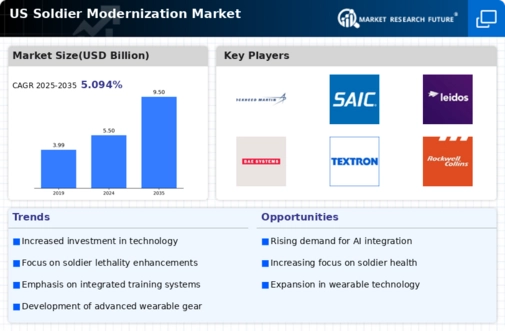Increased Defense Budgets
The soldier modernization market is experiencing a notable boost due to increased defense budgets across the United States. In recent years, the U.S. government has allocated substantial funds to enhance military capabilities, with a projected budget of over $800 billion for defense in 2025. This financial commitment is likely to drive investments in advanced soldier systems, including personal protective equipment, communication technologies, and weaponry. As a result, the soldier modernization market is expected to grow at a CAGR of approximately 5% through 2030, reflecting the urgency to equip soldiers with state-of-the-art tools and technologies. The focus on modernization is not only about enhancing combat effectiveness but also about ensuring that soldiers are better prepared for diverse operational environments.
Technological Advancements
Technological advancements play a pivotal role in shaping the soldier modernization market. Innovations in areas such as artificial intelligence, robotics, and wearable technologies are transforming how soldiers operate on the battlefield. For instance, the integration of AI-driven systems can enhance situational awareness and decision-making processes, potentially reducing response times in critical scenarios. The soldier modernization market is projected to reach $20 billion by 2027, driven by these technological innovations. Furthermore, the development of smart textiles and augmented reality systems is likely to improve soldier performance and safety, indicating a shift towards more integrated and efficient combat systems. As these technologies evolve, they will redefine the capabilities and effectiveness of modern soldiers.
Focus on Soldier Well-being
The soldier modernization market is increasingly prioritizing soldier well-being, reflecting a broader understanding of the importance of mental and physical health in military effectiveness. Programs aimed at improving resilience, mental health support, and physical fitness are gaining traction. The U.S. military has recognized that a healthy soldier is a more effective soldier, leading to investments in wellness programs and technologies. This focus is expected to drive a market growth rate of around 4% annually, as the soldier modernization market adapts to incorporate health and wellness solutions. By integrating these aspects into modernization efforts, the military aims to enhance overall operational readiness and reduce the incidence of stress-related issues among personnel.
Collaboration with Private Sector
Collaboration with the private sector is emerging as a crucial driver in the soldier modernization market. The U.S. military is increasingly partnering with technology firms and startups to leverage innovative solutions and accelerate the development of advanced soldier systems. This collaboration allows for the rapid integration of cutting-edge technologies, such as drones, AI, and advanced materials, into military applications. The soldier modernization market is expected to benefit from this synergy, with projections indicating a potential market size of $25 billion by 2030. By fostering partnerships with private entities, the military can enhance its capabilities and ensure that soldiers are equipped with the latest advancements, ultimately improving mission success rates.
Emerging Threats and Geopolitical Tensions
Emerging threats and geopolitical tensions are significant drivers of the soldier modernization market. The evolving nature of warfare, including cyber threats and asymmetric warfare, necessitates a reevaluation of military strategies and capabilities. The U.S. military is responding to these challenges by investing in advanced technologies and systems that enhance operational effectiveness. As a result, the soldier modernization market is likely to see an increase in demand for advanced surveillance systems, cyber defense mechanisms, and enhanced communication tools. This shift is indicative of a broader trend towards preparing soldiers for a complex and unpredictable operational landscape, with market growth projected at approximately 6% over the next five years.





















Leave a Comment